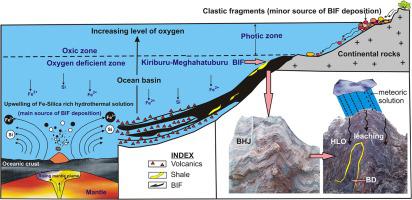Ore Geology Reviews ( IF 3.2 ) Pub Date : 2022-09-26 , DOI: 10.1016/j.oregeorev.2022.105125 Jitendra Prasad , Akella Satya Venkatesh , Prabodha Ranjan Sahoo

|
The high-grade (>62 wt% Fe) iron ores of Kiriburu-Meghahatuburu deposit (KMID) of the Singhbhum-Orissa region, eastern India are mainly hosted by banded hematite Jasper (BHJ) and shale. These BIFs belong to oxide facies (hematite ± martite) iron formations without sulfidic/carbonitic signatures. These BIFs have low concentrations of Al2O3 (0.86 wt%), TiO2 (0.13 wt%) and trace HFSE [(high field strength elements such as Zr (13 ppm), Hf (0.30 ppm), Ta (5 ppm), Pb (7 ppm) and Th (0.45 ppm)], reflecting minor amounts of clastic contamination. The SiO2-Zr/TiO2 ratios and the binary plots between certain trace elements, e.g., Hf-Zr and Zr-Y indicate clastic contamination derived from various sources. The weak positive chondrite normalized Eu anomaly (average 1.13) in BHJ, associated with low V (7 ppm) and Ni (17 ppm) contents are analogous to the Superior-type BIFs worldwide, and are consistent with deposition in a submarine hydrothermal environmental setting under low oxygenated environment. Positive Eu anomalies and the Y/Ho vs Eu/Sm relationships indicate mixing of seawater with a small amount of high-temperature hydrothermal fluids (<0.1 %). Based on the field studies, ore mineralogical and geochemical signatures, a “polygenic-supergene- hydrothermal” model has been proposed for the genesis of Kiriburu-Meghahatuburu BIFs that can be used in understanding the mineralogical variations in the iron ores and their genetic aspects at KMID which has implications for exploration.
中文翻译:

印度东部辛格布姆克拉通太古宙基里布鲁-梅加哈图布鲁铁矿床带状铁层的海底热液成因
印度东部 Singhbhum-Orissa 地区 Kiriburu-Meghahatuburu 矿床 (KMID) 的高品位 (>62 wt% Fe) 铁矿石主要由带状赤铁矿碧玉 (BHJ) 和页岩组成。这些 BIF 属于没有硫化物/碳酸盐特征的氧化物相(赤铁矿±马铁矿)铁地层。这些 BIF 具有低浓度的 Al 2 O 3 (0.86 wt%)、TiO 2 (0.13 wt%) 和痕量 HFSE [(高场强元素,例如 Zr (13 ppm)、Hf (0.30 ppm)、Ta (5 ppm) )、Pb (7 ppm) 和 Th (0.45 ppm)],反映少量碎屑污染。SiO 2 -Zr/TiO 2某些微量元素(例如 Hf-Zr 和 Zr-Y)之间的比率和二进制图表明来自各种来源的碎屑污染。BHJ 中的弱正球粒陨石归一化 Eu 异常(平均 1.13),与低 V(7 ppm)和 Ni(17 ppm)含量相关,类似于世界范围内的高级型 BIF,并且与海底热液环境中的沉积一致在低氧环境下。正 Eu 异常和 Y/Ho 与 Eu/Sm 关系表明海水与少量高温热液流体 (<0.1 %) 混合。根据实地研究、矿石矿物学和地球化学特征,











































 京公网安备 11010802027423号
京公网安备 11010802027423号